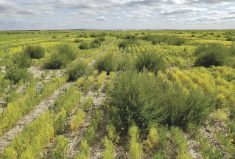Planting conditions in the falls of 2013 and 2014 were difficult, to say the least. Only 800,000 acres of winter wheat were planted in 2013 (with roughly 675,000 acres harvested last year) and about 600,000 acres planted last fall. Early assessments done in the spring labelled many of those fields as, at best, “decent.”
Winter wheat had a rough ride in Ontario for the past two years, and that’s a fact that’s hard to escape. Still, there is considerable optimism heading into the fall of 2015. Expectations are high that farmers will be able to plant winter wheat this year, and straw continues to command a healthy premium.
Read Also

Agronomists share tips for evaluating new crop products and tech: Pt. 3
With new products, new production practices and new technology converging on the agriculture industry at a frenetic pace in recent…
Speaking of premiums, soft white winter wheat may be making a small comeback, if certain seed dealers can convince growers to practise a little more patience and diligence.
- More on Country Guide: Needed: Soft white winter wheat
In the meantime, Country Guide‘s Crops Guide section is introducing a new feature: What’s new in varieties and hybrids. This will be our inaugural entry featuring winter cereal varieties. Admittedly, the listing is limited, yet given the market and the potential for more acres in the fall, it’s important to let you know what’s new at your seed dealership.
We’re also planning similar features for corn, soybeans, identity-preserved/food-grade soybeans and edible beans, spring cereals and forages. And it’s being done with the intent of keeping you better informed as new seeds, traits and technologies become available in the next six to eight months.
 C&M Seeds
C&M Seeds
C&M Seeds is marking 2015 with three new varieties in two winter cereal crops — winter wheat and winter rye.
Brasetto comes to the market as the first hybridized cereal available to Ontario growers, with yields from 20 to 50 per cent greater than other sources of rye. It also has strong milling qualities. Growers looking to produce rye for that milling market should see an instant increase in their bottom line. Look for Brasetto if you’re an Ontario rye grower.
Cruze is a new soft red winter wheat variety (registration pending) that has excellent standability, combined with an above-average disease package, including good tolerance to fusarium head blight. This variety responds very well to intensive management and has a high yield potential. Although it is best suited to southern Ontario conditions, it’s been found to perform well in midwestern Ontario, as well.
Gallus was released in 2014 but only in a limited quantity, yet it carries many of the characteristics that hard red winter wheat growers are looking for. It has high yield potential, is of short height with excellent standability, and has good protein levels. This variety is suited to all soil types but it performs best in intensive management scenarios. Gallus growers will also notice its early maturity versus other hard red varieties.
For more information, visit the C&M Seeds website.

Elite Seeds
OAC Flight is another variety that was launched in 2014 but only in limited supply. A soft red winter wheat, OAC Flight is from University of Guelph’s winter wheat-breeding program. This cultivar has gone through the OCCC registration trials from 2008 to 2009 and has been tested in the performance trials since 2011. That totals 34 site-years of testing.
OAC Flight has yielded well in all Ontario zones and especially in Area I and II where it responded very well to a more intensive management program. Its soil adaptation is broad and its yield stability is established on a strong genetic makeup. It differentiates itself through good resistance to fusarium plus better overall plant health compared to other commercial standards, including Emmit. The combination of its slight above-average height, its very good tillering capacity and its lodging resistance results in abundant quality straw yield.
Seed in Ontario through the Agromart network.

















